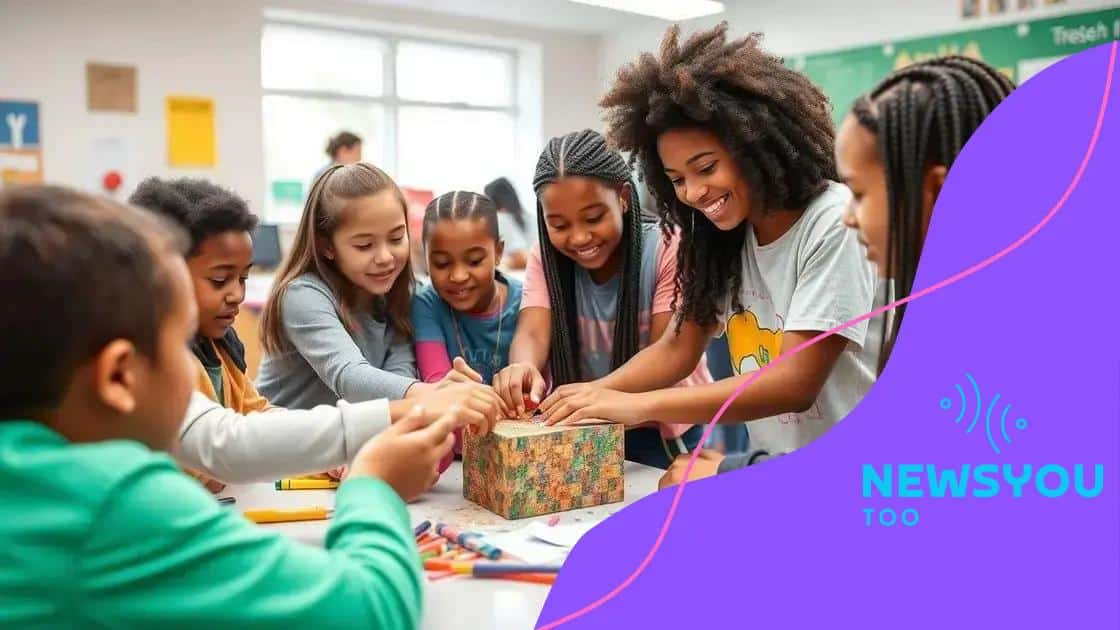How project-based learning is transforming education for students

Anúncios
Project-based learning transforms education by engaging students in hands-on projects that foster critical thinking, collaboration, and real-world problem-solving skills, preparing them for future challenges.
How project-based learning is transforming education is an exciting shift that many educators are embracing. Have you noticed how hands-on activities seem to spark more interest? This approach encourages students to take charge of their learning.
Anúncios
Understanding project-based learning
Understanding project-based learning is essential for grasping its impact in today’s educational landscape. This teaching method places students at the center of their learning experience, encouraging them to engage deeply with the subject matter.
In a project-based learning environment, students tackle real-world problems and develop projects that reflect their knowledge and skills. They learn by doing, which often leads to a more meaningful educational experience. This approach fosters critical thinking, creativity, and collaboration.
The principles of project-based learning
To fully appreciate project-based learning, it’s important to understand its core principles:
Anúncios
- Active learning: Students participate in the learning process instead of passively receiving information.
- Real-world relevance: Projects are based on issues and challenges that students face in their daily lives.
- Collaboration: Students often work in teams, enhancing their social skills and ability to work with others.
- Reflection: Learners regularly evaluate their progress and the process of learning itself, allowing for growth.
These principles create a dynamic learning environment where students are motivated to engage with and explore their subjects in-depth. By participating in hands-on projects, they develop both academic and practical skills that are beneficial for their future.
Benefits of project-based learning
One of the significant advantages of project-based learning is the degree of ownership students feel over their work. They become more invested in the learning process and see the direct impact of their efforts. This sense of ownership often leads to improved academic performance.
Moreover, students in these environments often display higher levels of engagement and enthusiasm for learning. They discover the joy of solving problems and creatively expressing ideas. This strategy not only builds essential skills but also prepares students for real-life situations.
Understanding project-based learning and its benefits helps educators create more engaging and effective learning experiences. Schools that embrace this methodology foster a culture of curiosity and innovation, shaping students who are ready to tackle the challenges of tomorrow.
Key benefits of project-based education

Key benefits of project-based education highlight why this teaching approach is gaining popularity. Students learn in ways that actively engage them and connect to their interests.
One major benefit is that students develop critical thinking skills. Through project-based education, they analyze problems, come up with solutions, and present their findings. This not only boosts their understanding but also prepares them for real-world challenges.
Enhanced engagement in learning
Students in project-based environments often feel more motivated. When projects are relevant to their lives, they invest more effort. This engagement results in deeper learning. They explore topics more thoroughly and take pride in their work. Students also appreciate the creative freedom to express their ideas.
- Improved retention: Hands-on projects help students remember information longer.
- Collaboration skills: Working together on projects teaches teamwork and communication.
- Real-world connections: Students relate schoolwork to the outside world, making learning meaningful.
Another essential benefit of project-based education is the emphasis on collaboration. Students frequently work in groups, which helps them build social skills. They learn from one another and gain different perspectives. This collaborative spirit fosters a supportive learning environment, where risks are encouraged, and innovation flourishes.
Development of practical skills
Students acquire essential skills beyond academics in this approach. Projects often require research, planning, and execution. These experiences teach students how to manage time and resources effectively. They become self-directed learners, responsible for their progress. By tackling various challenges, they build resilience as well.
In summary, the key benefits of project-based education encompass enhanced engagement, critical thinking, collaboration, and the development of practical skills. These attributes prepare students for success in school and beyond, making it a valuable approach in modern education.
Real-world applications of project-based learning
Real-world applications of project-based learning illustrate how this educational approach translates into practical skills and experiences. In today’s fast-paced world, students benefit significantly from engaging in projects that connect classroom learning to real-life scenarios.
For instance, students can participate in community service projects that address local issues. Through these initiatives, they learn to identify problems and create solutions. This not only enhances their problem-solving skills but also strengthens their ties to the community.
Examples of project-based learning in action
Many schools have implemented project-based learning projects that showcase its effectiveness in real-world settings. Here are a few notable examples:
- Environmental projects: Students can work on projects that promote sustainability, such as creating recycling programs or organizing clean-up days.
- Entrepreneurial ventures: Some students develop business plans for a product or service, pitching their ideas to local investors.
- Historical reenactments: Learners can recreate historical events, enhancing their understanding of history while also developing teamwork skills.
These projects not only teach valuable academic content but also equip students with the skills necessary for future success. Project-based learning encourages collaboration and communication, essential skills in today’s workforce.
Building connections through projects
Another crucial aspect of project-based learning is the ability to build connections. When students engage with community members, local businesses, and organizations, they gain insights into the practical applications of their studies. This interaction opens doors for mentorship and internships that boost their career readiness.
Furthermore, students get the chance to present their projects to real audiences. This experience enhances their public speaking skills and instills confidence. By sharing their findings and solutions, they develop a sense of accomplishment and purpose, knowing that their work makes a difference.
Through real-world applications, project-based learning transforms education by preparing students to navigate and contribute to the world around them. The hands-on experience they gain is invaluable as they transition into higher education or the workforce.
Challenges in implementing project-based learning

Challenges in implementing project-based learning can be significant, yet understanding these obstacles helps educators prepare for a successful transition. While the benefits are clear, various factors can complicate the implementation process.
One primary challenge is the need for proper teacher training. Many educators may not feel adequately prepared to guide students through project-based learning. Without comprehensive training, teachers might struggle to facilitate projects effectively. This can lead to confusion among students and hinder the learning process.
Time management and curriculum constraints
Another major challenge is the issue of time. Project-based learning often requires more time than traditional teaching methods. Completing thorough projects can conflict with standardized testing schedules and rigid curricula. Teachers may feel pressured to cover specific content, leaving little room for exploration.
- Balancing requirements: Finding the right balance between required curriculum and project time can be tough.
- Time allocation: Projects require careful planning and sufficient time to develop.
- Assessment pressures: Teachers often face pressure to meet assessment benchmarks, which can limit project opportunities.
These time constraints can make it difficult for teachers to dedicate the time necessary for meaningful projects, ultimately impacting the student experience.
Resource limitations
Another hurdle to successful project-based learning is the availability of resources. Schools may lack necessary materials, technology, or even space to conduct projects effectively. Without proper resources, students might find it challenging to engage in the hands-on experiences that project-based learning emphasizes.
Schools with limited budgets may struggle to provide the tools needed for successful projects. This lack of resources can restrict creativity and limit student opportunities to explore their interests fully.
Overcoming these challenges requires careful planning and support from school leaders. Addressing the need for resources and training, as well as managing time effectively, can lead to successful implementation. By recognizing these hurdles, educators can create a more effective project-based learning environment for their students.
Future trends in education with project-based learning
Future trends in education with project-based learning point towards more innovative and engaging teaching methods. As education continues to evolve, project-based learning remains at the forefront of these changes.
One significant trend is the integration of technology into project-based learning. As classrooms become more digital, students will use various tools and platforms to enhance their projects. These tools can range from coding programs to design software, giving students access to a wider array of resources.
The rise of collaborative learning environments
In the coming years, we can expect an increase in collaborative learning environments. Schools are beginning to emphasize teamwork and collaboration. This shift aligns perfectly with the principles of project-based learning, where students work together to solve problems. Collaborative projects foster communication skills and prepare students for future workplaces.
- Peer feedback: Students will provide and receive feedback from each other, enhancing their learning.
- Diverse teams: Working with classmates from different backgrounds can introduce new perspectives.
- Role assignment: Students will take on various roles in projects, mirroring real-world job situations.
The emphasis on collaboration also encourages students to develop important soft skills, such as empathy and adaptability.
Focus on personalized learning
Another vital trend is the push towards personalized learning experiences. As educators recognize that students learn at different paces, they will adapt projects to meet individual needs. This shift allows students to explore topics that genuinely interest them, increasing motivation and enthusiasm.
Students will have a say in choosing projects that resonate with their personal experiences and aspirations. This engagement leads to a deeper connection with the material. Consequently, project-based learning can become a more enriching and enjoyable experience.
With these future trends in education, project-based learning is poised to play a pivotal role. These changes will not only enhance learning experiences but also equip students with the skills they need for the challenges ahead. Preparing students for a rapidly changing world will remain at the heart of education.
FAQ – Frequently Asked Questions about Project-Based Learning in Education
What is project-based learning?
Project-based learning is an educational approach where students engage in hands-on projects to explore and solve real-world problems.
How does project-based learning benefit students?
It enhances critical thinking, collaboration, and creativity while making learning more engaging and relevant to students’ interests.
What challenges do teachers face when implementing project-based learning?
Teachers may struggle with resource limitations, lack of training, and managing time within the existing curriculum.
What are the future trends in project-based learning?
Future trends include greater integration of technology, personalized learning experiences, and a focus on collaborative environments.





